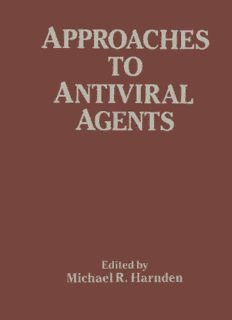
Approaches to Antiviral Agents PDF
Preview Approaches to Antiviral Agents
Approaches to Antiviral Agents APPROACHES TO ANTIVIRAL AGENTS Edited by Michael R. Harnden, USC, PhD, CChem, FRSC Beecham Pharmaceuticals Research Division Biosciences Research Centre Epsom, Surrey M MACMILLAN © The contributors 1985 Softcover reprint ofthe hardcover 1st edition 1985 978-0-333-35928-0 All rights reserved. No reproduction, copy or transmission of this publication may be made without written permission. No paragraph of this publication may be reproduced, copied or transmitted save with written permission or in accordance with the provisions of the Copyright Act 1956 (as amended). Any person who does any unauthorised act in relation to this publication may be liable to criminal prosecution and civil claims for damages. First published 1985 Published by THE MACMILLAN PRESS LTD Houndmills, Basingstoke, Hampshire RG21 2XS and London Companies and representatives throughout the world British Library Cataloguing in Publication Data Approaches to antiviral agents. 1. Antiviral agents 1. Harnden, Michael R. 615'.37 RC114.5 ISBN 978-1-349-06932-3 ISBN 978-1-349-06930-9 (eBook) DOI 10.1007/978-1-349-06930-9 Contents The contributors vii Preface ix Introduction M.R.Harnden xi SECTIONA Chapter I The clinical need for antiviral agents 3 R.J. Whitley SECTION8:SPECIFICINHIBITORSOFVIRALREPLICATION 13 Chapter2 Potential targets for selective inhibition ofviralreplication 15 I.S.Sim andK.G.McCullagh Chapter3 Syntheticpyrimidine nucleoside analogues 57 E.DeClercq Chapter4 Synthetic purine nucleoside analogues 101 A.Holy Chapter 5 Screening leads- syntheticcompounds 135 C.E.Hoffman Chapter6 Screeningleads - natural products 153 M.R.Hamden and D.N.Planterose SECTIONC:MODULATION OFHOSTDEFENCEMECHANISMS 181 Chapter 7 Potential targets for host defence modulation 183 K. L. Yap v vi Contents Chapter8 Interferons: directeffectsupon viralreplication 217 A. G.Hovanessian Chapter9 Interferons: immunoregulatory agents 261 J.L. Vire/izier Chapter 10 Induction ofinterferonsand modulation ofhost defence mechanisms 279 D.A.Stringfellow SECTION D 293 Chapter 11 Assessment ofantiviral drugs in man B.E.Juel-Jensen 295 Concludingremarks M.R.Hamden 309 Index 315 The contributors DeClercq, E. RegaInstituteforMedicalResearch KatholiekeUniversiteit Leuven B-3000Leuven Belgium Harnden,M.R. BeechamPharmaceuticals BiosciencesResearch Centre GreatBurgh Epsom Surrey Hoffman,C.E. E.I. DuPontdeNemours andCompany PharmaceuticalsDivision Newark Delaware 19711 USA HolY,A. InstituteofOrganicChemistryand Biochemistry CzechoslovakAcademy ofSciences 166 10Prague6 Czechoslovakia Hovanessian,A.G. Institut Pasteur Unite d'OncologieVitale 75724 ParisCMex 15 France Juel-Jensen,B.E. Nuffield DepartmentofMedicine University ofOxford Radcliffe Infirmary OxfordOX26HE McCullagh,K.G. Research and DevelopmentDivision G.D.SearleandCo.Ltd HighWycombe BucksHP124HL vii viii Thecontributors Planterose,D.N. BeechamPharmaceuticals BiosciencesResearchCentre GreatBurgh Epsom Surrey Sim,l.S. Researchand DevelopmentDivision G.D.SearleandCo.Ltd HighWycombe BucksHP124HL Presentaddress: DepartmentofExperimentaland Applied Biology HoffmanLaRoche Inc. Nutley NewJersey 07110 USA Stringfellow,D.A. Cancer Research Bristol-MyersPharmaceuticalResearch and Development Syracuse NewYork USA Virelizier,J. L. Unite d'Immunologieet deRhumatologiePediatrique Hopital Necker-EnfantsMalades 75743 ParisCedex 15 France Whitley,R.J. DepartmentsofPediatricsand Microbiology University ofAlabamainBirmingham Birmingham Alabama 35294 USA Yap.K.L. DepartmentofMicrobiology FacultyofMedicine The National University ofMalaysia KualaLumpur Malaysia Preface More than in most fields ofscientific endeavour,the discovery and development of new medicinal agents requires the involvement and interaction of investi gators trained in many different disciplines. This isespecially true in the quest for antiviral agents, where chemistry, biochemistry, virology, immunology, pharmacology and medicine each have a significant role to play. This book attempts to achieve a synthesis of currently available scientific and medical information relevant to the discovery and application ofantiviral agents. The need for antiviral drugsand the usefulness and limitationsofthose which are approved for administration to man are discussed. Specific biochemicaland biological targets for compounds that can either inhibit selectively the replica tion of viruses, or that can modulate beneficially host defensive responses to viral infections, are identified and the mechanisms of action and biological properties of known antiviral compounds are described. The authors of each chapterareacknowledgedexpertson thatparticulartopic,providinganauthorita tive account and critical evaluation ofpresent knowledge. It is hoped that this will stimulate new ideas leading to additional drugs ofuse in the treatment of an importantgroup ofinfectiousdiseases. The editor would like to express his thanks to the management of Beecham Pharmaceuticals, Research Division, for allowing him the facility to organise this bookand to the contributorsfor their timely and thoughtful chapters. Epsom, Surrey,1985 M.R.H. ix Introduction M.R. Harnden The development of clinically useful antiviral agents has proceeded at a much slower rate than has the developmentofantibacterial agents.There areanumber of reasons for this. Viruses are intracellular parasites and their replication is closely integrated with host cell metabolism. There are therefore relatively few virus-specific processes that can be inhibited selectively. Consequently, most of the antiviral agents known until fairly recently also inhibit normal mammalian cell metabolism at concentrations similar to those at which they show antiviral activity. These cell inhibitory properties result in immunosuppression, terato genicity and other toxic effects in animals. Such toxicity can be tolerated in the treatment ofviralinfections that are potentiallylethal or could causeperma nent disability, such as herpesvirus infections in immunocompromised patients. However,although there isanenormously highmorbidity due to viralinfections, particularly those of the respiratory tract, digestive tract and skin, in most individuals the vast majority of infections are temporarily uncomfortable and perhaps incapacitating, but not life-threatening. In these circumstances,inorder to achieve a significant clinical benefit for the toxicological risk involved in chemotherapeutic intervention, an extremely potent and non-toxic agent is required. Additionally, prophylactic immunisation has proved to be highly successful in the prevention ofimportant viral diseasessuch as smallpox, polio and measles, and for many other diseases vaccine development must be con sidered as an alternative strategy which,if successful, could abolish the require ment for antiviral chemotherapy. It is not, therefore, altogether surprising that the research effort that has been directed towards the discovery of antiviral agents has been much lessthan that directed towardsfinding antibacterialdrugs. The recently increased level ofinterest inantiviral chemotherapy isrestricted mainly to those diseases against which, for various reasons, it is thought that vaccines are likely to have limited efficacy and has been stimulated by several concurrent developments. First, there have been considerable advances in our knowledge of the detailed biology and biochemistry of virus replication. For some Viruses, notably those of the herpesvirus family, specific enzymes have xi
